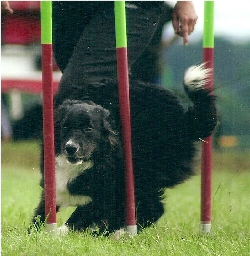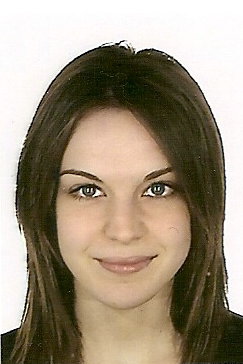Murphy: A case study
 McTimoney
therapist Anna Rowland has been treating Murphy since last April when Jo Bird brought him to
her for a back check as he is prone to problems. Poor old Murph has had his fair share of
problems, which is why Anna thought using him for a case study would make for interesting
reading especially for agility handlers. McTimoney
therapist Anna Rowland has been treating Murphy since last April when Jo Bird brought him to
her for a back check as he is prone to problems. Poor old Murph has had his fair share of
problems, which is why Anna thought using him for a case study would make for interesting
reading especially for agility handlers.
|
Vital Statistics |
|
Owner: |
Jo Bird |
|
Dog: |
Murphy |
|
Sex: |
Dog |
|
Age of
dog: |
4 1/2 years |
|
Breed: |
Collie |
|
Neutered: |
Yes |
| |
|
Animals just
like humans can suffer back, neck and muscular disorders from falls or accidents causing pain,
stiffness, lack of performance and behavioural changes. Therefore, animals such as horses,
dogs, cats and farm animals can benefit from McTimoney therapy. The aim of the treatment is to
maintain correct alignment of the spine to ensure correct function of the nervous system.
 History History
Murphy’s problems began with the floods last July. Murphy and Jo's three other dogs became
stranded upstairs in their flooded home for nearly 15 hours. By the time they were rescued, the
vets suspect Murphy had drunk some of the flood water which caused him to pick up an infection
from the highly toxic bacteria in the flood water. As a consequence of this infection, he
picked up pneumonia and a collapsed lung which subsequently had to be removed. Murphy was on a
number of drugs and steroids for months and has only recently come off the steroids. The side
effects of the steroids caused his coat to fall out in patches, and with one lung he can tire
easily.
Nevertheless,
Murphy continues to train and compete successfully at agility, and is training or competing
most days. He is very laid back at home but is highly strung when training which sometimes
makes it difficult to tell when he is sore or in pain. It is masked by adrenalin!
When Murphy first came to me, he had been treated by a fellow McTimoney
practitioner a few weeks before and had exhibited a number of problems! As with all my clients,
I took a case history from Jo. Then I did a conformational assessment and gait analysis.
The most noticeable weakness I noted for Murphy that his left hind limb
appeared to be held at an awkward angle. He was not lame but a conformational fault in an
animal can lead to compensations throughout the spine and musculature. This means that if one
part of the body is not moving correctly due to how it is put together, then other parts of the
body make up for this by over use of the corresponding structure usually on the other side.
Murphy is a large collie with a long back and long limbs.
Treatment
APRIL 2008:
After my initial assessments, I proceeded to palpate (feel) Murphy for any misalignments and
muscle tension throughout the neck, back, pelvis and hind quarters. Murphy is quite excitable
during treatment so we use treats to try and keep him as calm as possible so I can palpate
accurately.
His atlas (1st cervical/neck vertebrae) was sitting dorsal (upwards) on
the right hand side. His axis (2nd cervical/neck vertebrae) was dorsal on the left hand side.
The 3rd cervical vertebrae was dorsal on the right hand side and the 5th cervical
vertebrae was dorsal on the left. There are 7 cervical vertebrae in the neck all together.
He had a curve to the right hand side just behind the shoulder blades
(thoracic vertebrae 3rd – 7th), and then a curve to the left hand side in the middle to lower
back region (thoracic vertebrae 10th – 13th, lumbar vertebrae 1st). His pelvis was sitting
lower on the right hand side and back quite significantly on the left hand side.
So as you can tell there was a fair bit for me to treat! I adjusted Murphy
and he responded well to the treatment. I also did some soft tissue work (massage) to the
brachiocephalic muscle (neck) and also to the left gluteals (hind quarters). The left
hamstring was also tight and needed some attention.
I had to provide Jo with some very specific aftercare to ensure the
maximum effect of the treatment. It is so important that this aftercare is followed, as the
treatment can make the animal feel tired and even a little bit stiffer before they improve (I
undergo McTimoney treatment myself so experience this first hand!)
This is not the case with all animals. Sometimes an immediate improvement
is seen. However, the animal must have a quiet couple of days after the treatment to allow
the body to adapt. I advised Jo to ensure Murphy did not play roughly with the other dogs for
a few days and also no excitable tugging games etc. I advised her to leave any agility
training/jumping/strenuous exercise for one week, and then introduce his exercise
gradually. After care has to be tailored to the individual needs of each dog I treat.
I saw Murphy the following week to see how he was getting on. the
adjustments appeared to have held well and Murphy was on the mend.
JULY 2008: I
saw Murphy again. He had been lame at an agility training session one evening. As luck would
have it, he was off to the vets the next day for a different reason but Jo got them to check
him while she was there. They could not find anything and suggested a back check up. Sure
enough, Murphy had twisted his spine again and his pelvis was also misaligned - this time
sitting lower and further back on the left hand side. My feeling was that this was an acute
problem meaning that it had happened due to a knock or trauma of some sort and was fairly
recent. I corrected the misalignments and gave Jo the same after care as from the first
treatment.
SEPTEMBER 2008:
I saw Murphy again in September presenting with a similar stiffness in that left hind. I
treated him in the usual way but Jo and I began to realise that due to the way Murph is put
together, his highly strung temperament and active lifestyle, this may be an ongoing problem.
I discussed some options with Jo, trying to think of ways in which we could strengthen
Murphy’s musculature to help hold everything in place. We discussed hydrotherapy which
is ideal for non-weight bearing, strengthening exercise, and also using a pad/vet wrap around
that weak left hind limb to create awareness in the hope that he may use the limb more
efficiently.
Conclusion
Murphy’s active lifestyle means that the problems will be ongoing.
Regular treatments - four to six months for maintenance are recommended - will help to keep him
in good form. Jo and I will continue to pursue ideas such as the hydrotherapy which will help
to strengthen his musculature and therefore help to hold the skeletal structures in the correct
position.
 About
the author... About
the author...
Anna Rowland is a McTimoney Animal Therapist. She treats horses and dogs in the
Worcestershire / Gloucestershire area. She has a clinic for treating dogs at her home near to
Tewkesbury. Anna treats a variety of dogs including agility dogs, gun dogs, film dogs and pet
dogs.
Anna has two dogs of her own - Skye, a six years old Dobermann and Spice, a
six month old Labrador.
You can get more information about Anna and McTimoney therapy by contacting her
by email on
equinecaninetherapy@hotmail.co.uk by mobile: 07828) 776623 or by
visiting the website
www.equinecaninetherapy.co.uk
|